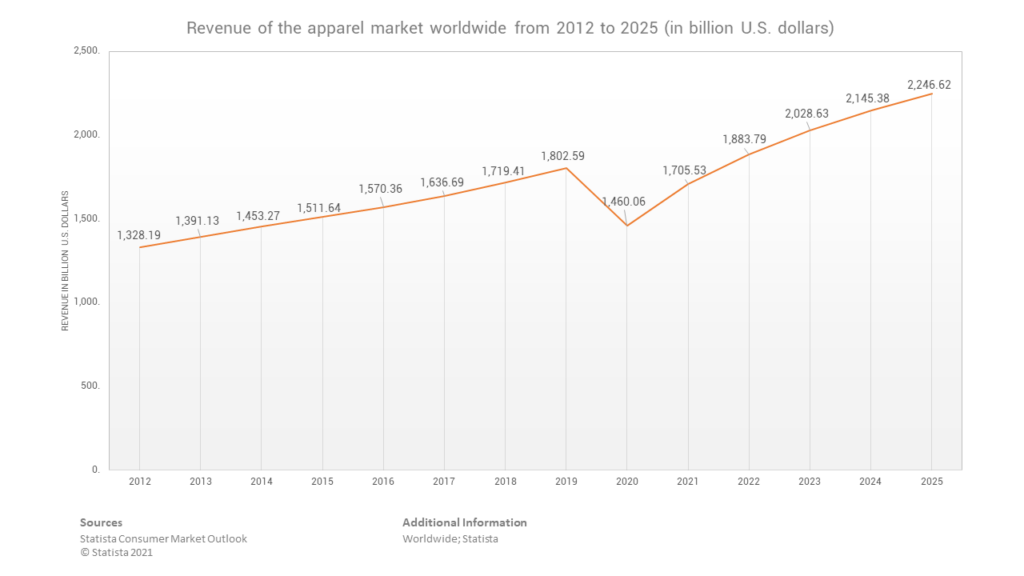According to Statista Market Outlook, over the forecast period, the global clothing market revenue is estimated to reach USD 2,246.62 Billion and register a revenue CAGR of 4.3% in 2025.
During the pandemic, people were driven by the desire to shop online which will continue to boost online spending in the years to come. Not only that, after the crisis, people are starting to go out again; to music concerts, festivals, gym, or as simple as having lunch outside. No wonder the clothing market revenue is expected to reach a large sum in 2025.
From the global market drivers, and customers spending power growth, to advance technology, there are many things that have the possibility to affect the clothing market revenue growth. Another factor that becomes more relevant is the trend towards sustainability given the environmental impact of the fashion industry.

Global Clothing Market Drivers
Some of the reasons for the rapid growth in the clothing industry are mainly caused by foreign direct investment rise, media development growth, and technological developments. Furthermore, as the demand for branded clothing keeps getting higher, the clothing market revenue is rising, too. The arising of branded and local clothing also helps with the emergence of new clothing trends.
For instance, have you heard of the corporate or work style? Those clothing brands provide an easy demonstration of an enterprise’s corporate culture, such as button-down shirts. Clothing brands are also reaping immense traction in organized retail stores and innovating product line extensions. Hence, the clothing market revenue is expected to sky-rocketing in 2025.
Clothing manufacturers’ endeavors also play a big part in the growth of clothing market revenue. With new technologies, they came up with innovative garments and experimented with clothes in terms of design, material, quality, features, and many more. The youngsters are also being targeted as potential customers by the existing players in the global clothing market.
This resulted in increased spending power and a rise in preference for innovative, comfortable, quiet, and lightweight premium clothes. The clothing market revenue growth is also boosted by product premiumization as the price is driven to rise.
Regional Clothing Market Insight
In 2020, the clothing market revenue already reached 23% of global online shares, and probably will still be growing in the coming years. The largest online clothing market revenue share is contributed by Asia Pacific in 2020 and is estimated to register the fastest revenue growth rate over the forecast period. The East and Southeast Asia regions also accounted for the growth of reached revenue.
This is due to a more extensive consumer base and rising disposable income, especially amongst middle-class income. Thus, the cause for market region growth is the presence of leading market players. In addition, social media content, enabling high-speed, “inspire and sell” customer conversion (like Instagram Shop, TikTok Shop, and Facebook Shop) acts as one of the leading trends for direct integration of shopping functionality.
Meanwhile, the market in North America also contributed to a significant revenue share in 2020, attributed to increasing research and development in high-performance clothing and protective garments. In addition, the rise in the number of sports activities along with fitness clothing apparel and the increasing demand for protective clothing in the defense sector in the region is fuelling market revenue growth.
With the advancement of digital technology and apps, people are increasingly shifting from desktop to mobile, facilitated by easy and crucial checkout systems as well as experiences.
The Key Highlights
To make it simple, there are 3 key highlights that affect the clothing market revenue growth for the upcoming years.
By Fabric Type
The synthetic fabrics segment contributed to the largest market revenue share in 2020. The majority of synthetic/man-made fabrics have better elasticity and are resistant to easy wrinkling. Fabrics produced from synthetic fabrics are usually more cost-effective, durable, and readily available than other fabric types. New product development in this area is probably the most promising for technological progress in the near future.
By Usage
Owing to an improved women-to-men ratio as well as an increasing population of working women, the women’s clothing segment accounted for the largest revenue share in 2020. Some of the things that drive the clothing market revenue growth are constant changes in clothing trends, the availability of the latest fashion statements by dedicated magazines, and endorsement by renowned personalities. Additionally, increasing innovations by market players in designing occasion-specification clothing accessories for women are boosting the clothing market revenue growth.
By Distribution Channel
Over the forecast period, the online segment is expected to grow at a rapid rate. Due to the better experience, such as comfort and convenience, online sales of clothing have witnessed increasing growth in the past couple of years. People love online shopping because they can just directly order anything straight from their mobiles.
The increasing internet penetration and the emergence of these online shops and e-commerce websites have significantly enhanced fashion consciousness and easy availability of local, fast, luxury products, and many more. The sustainability question remains largely unsolved, whether fashion can ever be sustainable. Regardless of the exact development, the global fashion market overall is predicted to continue to grow substantially.




